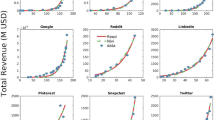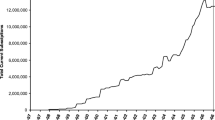Abstract
Many markets include a product and a platform product, where the product can only achieve its intended functions and performance in conjunction with or under the operation of its platform, such as a video game can only run on its game console. The growth of the user population of these products or services is a kind of collective behaviour propagation phenomenon. Here, questions come: how can we describe the collective behaviour propagation as a function of time? How the endogenous and exogenous social effects influence the collective behaviour propagation and how to quantify these two effects? In order to answer all these questions, an ordinary differential equation model is proposed to describe the growth of the user population of this class of markets. Firstly, a networked community is constructed, where users and prospective users are considered as nodes, and their relationship provides the method of building edges. Then, two fundamental influences of decision-making can be realized based on the network. A useful application of the model can be conceived and illustrated by one new database containing weekly sales of 25,237 video games released in the home and handle consoles and personal computer in USA, UK, Germany, France and Japan from 1989 to 2018. Results show that historical sales profile of a video game follows the growth equation, and the numerical procedure for finding the model parameters allows the market size, and the relative effectiveness of customer service and promotional efforts to be estimated according to the available historical data.




Similar content being viewed by others
References
Lee JG, Moon S, Salamatian K (2010) An approach to model and predict the popularity of online contents with explanatory factors. In: 2010 IEEE/WIC/ACM international conference on web intelligence and intelligent agent technology (WI-IAT), vol 1. IEEE, pp 623–630
Geroski PA (2000) Models of technology diffusion. Res Policy 29(4):603–625
Goldenberg J, Libai B, Muller E (2001) Talk of the network: a complex systems look at the underlying process of word-of-mouth. Mark Lett 12(3):211–223
Campbell A (2013) Word-of-mouth communication and percolation in social networks. Am Econ Rev 103(6):2466–2498
Rodrigues T, Benevenuto F, Cha M, Gummadi K, Almeida V (2011) On word-of-mouth based discovery of the web. In: Proceedings of the 2011 ACM SIGCOMM conference on Internet measurement conference, ACM, pp 381–396
Ahmed M, Spagna S, Huici F, Niccolini S (2013) A peek into the future: predicting the evolution of popularity in user generated content. In: Proceedings of the sixth ACM international conference on Web search and data mining. ACM, pp 607–616
Crane R, Sornette D (2008) Robust dynamic classes revealed by measuring the response function of a social system. Proc Natl Acad Sci 105(41):15649–15653
Sornette D, Deschâtres F, Gilbert T, Ageon Y (2004) Endogenous versus exogenous shocks in complex networks: an empirical test using book sale rankings. Phys Rev Lett 93(22):228701
Strogatz SH (2001) Exploring complex networks. Nature 410(6825):268–276
Albert R, Barabási A-L (2002) Statistical mechanics of complex networks. Rev Mod Phys 74(1):47
Centola D (2010) The spread of behaviour in an online social network experiment. Science 329(5996):1194–1197
Goel S, Anderson A, Hofman J, Watts DJ (2015) The structural virality of online diffusion. Manag Sci 62(1):180–196
Young HP (2009) Innovation diffusion in heterogeneous populations: contagion, social influence, and social learning. Am Econ Rev 99(5):1899–1924
Young HP (2011) The dynamics of social innovation. Proc Natl Acad Sci 108(Supplement 4):21285–21291
Leskovec J, Adamic L A, Huberman B A (2007) The dynamics of viral marketing. ACM Trans Web (TWEB) 1(1):5
Iribarren JL, Moro E (2011) Affinity paths and information diffusion in social networks. Soc Netw 33(2):134–142
Zhan C, Tse CK (2016) A universal model for growth of user population of products and services. Netw Sci 4(4):491–507
Zhan C, Tse CK (2016) A network model for growth of publications and citations. J Complex Netw. https://doi.org/10.1093/comnet/cnw019
Kotler P, Armstrong G (2010) Principles of marketing. Pearson Education, London
Pastor-Satorras R, Vespignani A (2002) Epidemics and immunization in scale-free networks. Wiley Online Library, Berlin
May RM, Lloyd AL (2001) Infection dynamics on scale-free networks. Phys Rev E 64(6):066112
Pastor-Satorras R, Vespignani A (2001) Epidemic spreading in scale-free networks. Phys Rev Lett 86(14):3200
Zhan C, Yeung LF (2011) Parameter estimation in systems biology models using spline approximation. BMC Syst Biol 5(1):14
Zhan C, Situ W, Yeung LF, Tsang PW-M, Yang G (2014) A parameter estimation method for biological systems modelled by ODE/DDE models using spline approximation and differential evolution algorithm. IEEE/ACM Trans Comput Biol Bioinform (TCBB) 11(6):1066–1076
Shcherbakov MV, Brebels A, Shcherbakova NL, Tyukov AP, Janovsky TA, Kamaev VA (2013) A survey of forecast error measures. World Appl Sci J 24:171–176
Zhang H, Cao X, Ho JK, Chow TW (2017) Object-level video advertising: an optimization framework. IEEE Trans Ind Inform 13(2):520–531
Zhang H, Li J, Ji Y, Yue H (2017) Understanding subtitles by character-level sequence-to-sequence learning. IEEE Trans Ind Inform 13(2):616–624
Jia Q, Tang WK (2018) Event-triggered protocol for the consensus of multi-agent systems with state-dependent nonlinear coupling. IEEE Trans Circuits Syst I Regul Pap 65(2):723–732
Jia Q, Tang WK (2018) Consensus of multi-agents with event-based nonlinear coupling over time-varying digraphs. IEEE Trans Circuits Syst II Express Briefs. https://doi.org/10.1109/TCSII.2018.2790582
Acknowledgements
This work was supported by National Science Foundation of China (61703355) and Guangdong Youth University Innovative Talents Project (2016KQNCX223). Also thanks to Mr. Guixiang Yang for his advice and help in charting.
Author information
Authors and Affiliations
Corresponding author
Rights and permissions
About this article
Cite this article
Zhan, C., Li, B., Zhong, X. et al. A model for collective behaviour propagation: a case study of video game industry. Neural Comput & Applic 32, 4507–4517 (2020). https://doi.org/10.1007/s00521-018-3686-8
Received:
Accepted:
Published:
Issue Date:
DOI: https://doi.org/10.1007/s00521-018-3686-8




